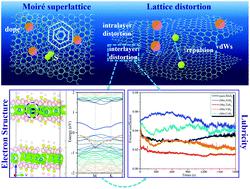Our official English website, www.x-mol.net, welcomes your feedback! (Note: you will need to create a separate account there.)
Lattice distortion-enhanced superlubricity of (Mo, X)S2 (X = Al, Ti, Cr and V) with moiré superlattice
Nanoscale ( IF 6.7 ) Pub Date : 2021-09-01 , DOI: 10.1039/d1nr02382a Peixuan Li 1 , Jiaqi Lu 1, 2 , William Yi Wang 1, 3 , Xudong Sui 4 , Chengxiong Zou 1, 3 , Ying Zhang 1 , Jun Wang 1, 3 , Deye Lin 5 , Zhibin Lu 4 , Haifeng Song 6 , Xiaoli Fan 1 , Junying Hao 4 , Jinshan Li 1, 3 , Weimin Liu 1
Nanoscale ( IF 6.7 ) Pub Date : 2021-09-01 , DOI: 10.1039/d1nr02382a Peixuan Li 1 , Jiaqi Lu 1, 2 , William Yi Wang 1, 3 , Xudong Sui 4 , Chengxiong Zou 1, 3 , Ying Zhang 1 , Jun Wang 1, 3 , Deye Lin 5 , Zhibin Lu 4 , Haifeng Song 6 , Xiaoli Fan 1 , Junying Hao 4 , Jinshan Li 1, 3 , Weimin Liu 1
Affiliation

|
Two-dimensional (2D) materials with the advantage of low interlayer shear strain are ultilized as lubricants in aerospace and precision manufacturing. Moiré superlattices (MSL), with attractive physical properties of electronic structures, interlayer hybridization and atomic forces, have been widely investigated in superlubricity, which is caused by elimination of interlayer lock-in by incommensurate atomic reconstruction. Although the foundations of superlubricity and the development of 2D lubricants via vanishing friction have been investigated, it is still important to comprehensively reveal the influence of MSL on the interlayer van der Waals (vdW) interactions of 2D lubricants. Here, the contributions of lattice distortions of solute-doped twisted bilayers (Mo, X)S2 (X = Al, Ti, V and Cr) to superlubricity are comprehensively investigated by high-throughput modelling and DFT-D2 calculations. It is revealed that the lattice distortion not only breaks the interlayer balance of repulsion and van der Waals interactions but also yields layer corrugation. These layer-corrugation-induced changes of the interlayer interactions and spacing distances are utilized to optimize lubricity, which matches with the experimental friction coefficients in the order of (Mo, Al)S2 > (Mo, Cr)S2 > MoS2 >(Mo, V)S2 >(Mo, Ti)S2. The evolutions of the band structures show an exponential relationship of the band edge width and layer deformations, paving a path to accelerate the development of advanced superlubricity materials via lattice distortions.
中文翻译:

(Mo, X)S2 (X = Al、Ti、Cr 和 V) 的晶格畸变增强超润滑性与莫尔超晶格
具有低层间剪切应变优势的二维 (2D) 材料被用作航空航天和精密制造中的润滑剂。莫尔超晶格 (MSL) 具有吸引人的电子结构物理特性、层间杂化和原子力,在超润滑性方面得到了广泛的研究,这是由于通过不相称的原子重建消除层间锁定引起的。尽管已经研究了超润滑性的基础和通过消失摩擦开发 2D 润滑剂,但全面揭示 MSL 对 2D 润滑剂的层间范德华 (vdW) 相互作用的影响仍然很重要。这里,溶质掺杂的扭曲双层 (Mo, X)S 2的晶格畸变的贡献(X = Al、Ti、V 和 Cr) 到超润滑性通过高通量建模和 DFT-D2 计算进行了全面研究。结果表明,晶格畸变不仅破坏了排斥力和范德华相互作用的层间平衡,而且还产生了层褶皱。这些层-波纹引起的层间相互作用和间距的变化被用来优化润滑性,这与实验摩擦系数匹配,顺序为 (Mo, Al)S 2 > (Mo, Cr)S 2 > MoS 2 > (Mo, V)S 2 >(Mo, Ti)S 2. 能带结构的演变显示了能带边缘宽度和层变形的指数关系,为通过晶格畸变加速先进超润滑材料的发展铺平了道路。
更新日期:2021-09-21
中文翻译:

(Mo, X)S2 (X = Al、Ti、Cr 和 V) 的晶格畸变增强超润滑性与莫尔超晶格
具有低层间剪切应变优势的二维 (2D) 材料被用作航空航天和精密制造中的润滑剂。莫尔超晶格 (MSL) 具有吸引人的电子结构物理特性、层间杂化和原子力,在超润滑性方面得到了广泛的研究,这是由于通过不相称的原子重建消除层间锁定引起的。尽管已经研究了超润滑性的基础和通过消失摩擦开发 2D 润滑剂,但全面揭示 MSL 对 2D 润滑剂的层间范德华 (vdW) 相互作用的影响仍然很重要。这里,溶质掺杂的扭曲双层 (Mo, X)S 2的晶格畸变的贡献(X = Al、Ti、V 和 Cr) 到超润滑性通过高通量建模和 DFT-D2 计算进行了全面研究。结果表明,晶格畸变不仅破坏了排斥力和范德华相互作用的层间平衡,而且还产生了层褶皱。这些层-波纹引起的层间相互作用和间距的变化被用来优化润滑性,这与实验摩擦系数匹配,顺序为 (Mo, Al)S 2 > (Mo, Cr)S 2 > MoS 2 > (Mo, V)S 2 >(Mo, Ti)S 2. 能带结构的演变显示了能带边缘宽度和层变形的指数关系,为通过晶格畸变加速先进超润滑材料的发展铺平了道路。



























 京公网安备 11010802027423号
京公网安备 11010802027423号